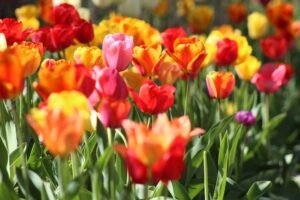Narcissus, also known as daffodil, is the birth flower for the month of December. As the year comes to a close and winter sets in, Narcissus blooms bring a burst of color and beauty to the season. Flowers have always held a special place in celebrations and traditions, symbolizing love, beauty, and new beginnings. In this article, we will explore the symbolic meaning of Narcissus as December’s birth flower, its history and origin as a festive flower, the different varieties of Narcissus for December birthdays, how to care for Narcissus as a houseplant or garden flower, its significance in art and literature, mythology and folklore surrounding Narcissus as a symbol of beauty, its importance in winter celebrations and festivals, the benefits of Narcissus essential oil for health and wellness, creative gift ideas featuring Narcissus, trends and innovations in Narcissus cultivation and floristry, and finally, the significance of flowers in celebrations and traditions.
Key Takeaways
- Narcissus is the birth flower for December and symbolizes rebirth, renewal, and hope.
- Narcissus has a long history as a festive flower, dating back to ancient Greek and Roman celebrations.
- There are over 50 different varieties of narcissus, including the popular Paperwhite and the fragrant Grand Soleil d’Or.
- Narcissus can be grown as a houseplant or garden flower, but requires proper care to prevent overwatering and rotting.
- Narcissus has been celebrated in art and literature for centuries, from the Greek myth of Narcissus to the works of William Wordsworth and Vincent van Gogh.
The Symbolic Meaning of Narcissus as December’s Birth Flower
In Greek mythology, Narcissus was a young man known for his extraordinary beauty. He was so enamored with his own reflection that he fell in love with it and could not tear himself away. Eventually, he wasted away and died by the side of the pool where he had been gazing at his reflection. From this mythological tale comes the symbolism of Narcissus as a representation of beauty and rebirth. The flower itself is often associated with vanity and self-love due to its connection to the myth of Narcissus. However, it also symbolizes new beginnings and the arrival of spring, as it is one of the first flowers to bloom after winter.
The History and Origin of Narcissus as a Festive Flower
Narcissus has a long history of being used in winter celebrations. In ancient Rome, it was believed that the arrival of Narcissus blooms signaled the end of winter and the beginning of spring. The flower was often used in religious ceremonies and festivals to celebrate the rebirth of nature. The origin of Narcissus as a festive flower can be traced back to the Mediterranean region, where it was first cultivated for its beauty and fragrance. Over time, it spread to other parts of Europe and eventually became popular worldwide.
The Different Varieties of Narcissus for December Birthdays
| Variety | Color | Bloom Time | Height | Fragrance |
|---|---|---|---|---|
| Paperwhite Narcissus | White | December-January | 12-18 inches | Strong |
| Tazetta Narcissus | White or Yellow | December-January | 12-18 inches | Mild |
| Cyclamineus Narcissus | Yellow | January-February | 6-12 inches | None |
| Jonquilla Narcissus | Yellow | February-March | 12-18 inches | Strong |
There are many different varieties of Narcissus, each with its own unique characteristics and beauty. Some popular varieties include the classic yellow daffodil, the white narcissus, the pink narcissus, and the double-flowered narcissus. The classic yellow daffodil is perhaps the most well-known variety, with its bright yellow petals and trumpet-shaped center. The white narcissus is known for its pure and delicate beauty, while the pink narcissus adds a touch of femininity to any garden or bouquet. The double-flowered narcissus is a showstopper with its multiple layers of petals, creating a stunning display.
How to Care for Narcissus as a Houseplant or Garden Flower
Narcissus is relatively easy to care for as a houseplant or garden flower. It prefers well-drained soil and should be planted in a sunny or partially shaded area. When planting bulbs, make sure to place them at a depth of about three times their height. Water regularly, but avoid overwatering as this can cause the bulbs to rot. After blooming, allow the foliage to die back naturally before cutting it back. This allows the bulbs to store energy for next year’s blooms. Common problems with Narcissus include pests such as aphids and slugs, as well as diseases like bulb rot. These can be treated with organic pest control methods or fungicides.
Narcissus in Art and Literature: A Celebration of December’s Birth Flower

Narcissus has long been celebrated in art and literature for its beauty and symbolism. In Greek mythology, the story of Narcissus has been depicted in countless paintings and sculptures. One of the most famous depictions is the painting “Narcissus” by Caravaggio, which shows the young man gazing at his reflection in a pool of water. In literature, Narcissus has been referenced in works such as Ovid’s “Metamorphoses” and T.S. Eliot’s poem “The Waste Land.” The flower’s delicate beauty and association with vanity and self-love have made it a popular subject for artists and writers throughout history.
The Mythology and Folklore Surrounding Narcissus as a Symbol of Beauty
Narcissus is not only prominent in Greek mythology but also appears in various mythologies and folklore from around the world. In Chinese mythology, Narcissus is associated with the story of a young man who falls in love with his own reflection and eventually turns into a flower. In Persian folklore, it is believed that the tears of Narcissus turned into the flowers we know today. These stories and legends highlight the universal fascination with beauty and the dangers of excessive self-love.
The Significance of Narcissus in Winter Celebrations and Festivals
Narcissus plays a significant role in winter celebrations and festivals around the world. In many cultures, it is seen as a symbol of hope and new beginnings, as its blooms mark the end of winter and the arrival of spring. In China, Narcissus is often used during the Lunar New Year celebrations to bring good luck and prosperity for the coming year. In Wales, it is customary to wear a daffodil on St. David’s Day, the national day of Wales, to celebrate the arrival of spring. These traditions and celebrations highlight the importance of Narcissus in cultural and religious festivities.
The Benefits of Narcissus Essential Oil for Health and Wellness
Narcissus essential oil is derived from the flowers of the Narcissus plant and has a wide range of health benefits. It is known for its calming and soothing properties, making it a popular choice for aromatherapy. The oil can help reduce stress and anxiety, promote relaxation, and improve sleep quality. It is also believed to have anti-inflammatory and antibacterial properties, making it useful for treating skin conditions such as acne and eczema. Additionally, Narcissus essential oil has a sweet and floral fragrance that can uplift the mood and enhance feelings of happiness and well-being.
Narcissus as a Gift: Creative Ideas for December Birthdays and Special Occasions
Narcissus makes a beautiful and meaningful gift for December birthdays and special occasions. A bouquet of Narcissus blooms can brighten up any room and bring a touch of springtime cheer to the winter season. For a more personalized gift, consider planting Narcissus bulbs in a decorative pot or container. This allows the recipient to enjoy the beauty of the flowers as they bloom and grow. Another creative idea is to give Narcissus essential oil or scented candles infused with its fragrance. These gifts not only smell wonderful but also provide the therapeutic benefits of the oil.
The Future of Narcissus: Trends and Innovations in Floristry and Horticulture
In recent years, there has been a growing interest in sustainable floristry and horticulture practices. This includes using locally grown flowers, reducing waste, and promoting biodiversity. In line with these trends, there has been an increased focus on cultivating native varieties of Narcissus that are better adapted to local climates and require less maintenance. Additionally, there has been a rise in the use of Narcissus in eco-friendly floral arrangements and wedding bouquets. These trends and innovations in Narcissus cultivation and floristry reflect a shift towards more sustainable and environmentally conscious practices.
Narcissus, with its vibrant blooms and rich symbolism, is a fitting birth flower for the month of December. Its association with beauty, rebirth, and new beginnings makes it a perfect choice for celebrating birthdays and special occasions during this time of year. Whether used in art, literature, mythology, or as a gift, Narcissus holds a special place in our cultural traditions and celebrations. As we continue to appreciate the beauty and significance of flowers in our lives, let us remember the importance of preserving and protecting these natural wonders for future generations to enjoy.
If you’re fascinated by the symbolism and meaning behind birth flowers, you’ll definitely want to check out this intriguing article on Just Tidings. It explores the enchanting December birth flower, the narcissus, and delves into its rich history and significance. Discover why this delicate bloom is associated with qualities like hope, rebirth, and prosperity. To learn more about the fascinating world of birth flowers and their hidden meanings, click here: https://justtidings.com/december-birth-flower-narcissus-symbolism-meaning/.




















+ There are no comments
Add yours